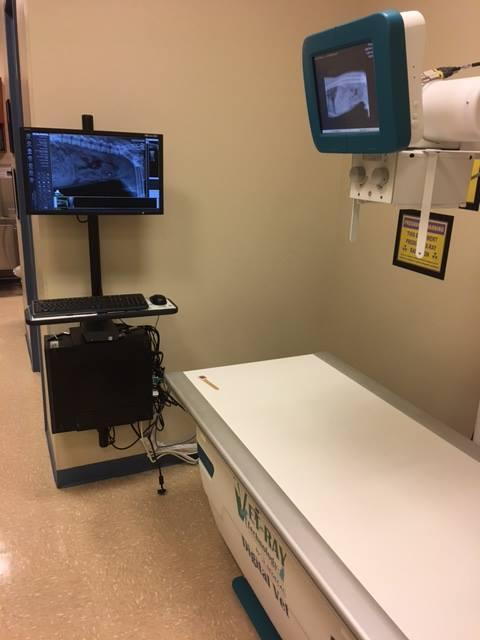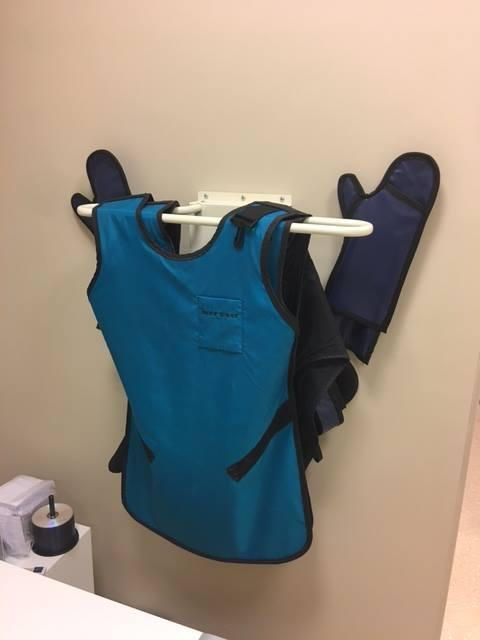What is it? The X-ray Machine
- posted: Mar. 29, 2017
"What is it?"
by Jim, Manager

In this installment of our new series we look at one of the most expensive pieces of equipment in any veterinary hospital – the X-ray. While we all know what the X-ray does, it is easy to forget just how incredible these machines are. A beam of invisible, radioactive light passes through an object. Softer materials like tissues and organs absorb only a little of the light, showing up black. Dense materials, like bones, absorb more light, showing up white. Sensors in the table read the light coming through, and create an internal image of the object. Older X-rays used film and worked somewhat like a big radioactive camera, but most today are digital. Some clinics have “converted” their film-based X-ray to “digital” hybrids using various devices, but ours is fully digital.
Film-based x-ray machines require a much larger amount of radiation than their digital counterparts. This means your pet receives less radiation with an x-ray machine like ours. Additionally, the digital image can be clearer and adjusted on the computer screen to pinpoint different issues. This allows us to see many of the major organs in detail. We can use the X-ray not only to look at the bones, but also to see blockages in the intestines, count the number of puppies in a pregnant dog, and see if Fido ate your car keys.
 While we use significantly less radiation than a standard x-ray machine, we still take precautions to protect our clients, patients, and staff. Leaded drywall has been installed around the machine to prevent radiation from leaving the x-ray area. Dosimeters, small radiation detectors clipped to our clothes, are used by our staff along with lead jackets, throat protectors, and gloves to monitor and minimize radiation exposure. Having a machine that uses a low amount of radiation makes this safe procedure even safer! Finally, government agencies monitor the machine and its safe use.
While we use significantly less radiation than a standard x-ray machine, we still take precautions to protect our clients, patients, and staff. Leaded drywall has been installed around the machine to prevent radiation from leaving the x-ray area. Dosimeters, small radiation detectors clipped to our clothes, are used by our staff along with lead jackets, throat protectors, and gloves to monitor and minimize radiation exposure. Having a machine that uses a low amount of radiation makes this safe procedure even safer! Finally, government agencies monitor the machine and its safe use.
Pets prone to certain conditions, like hip dysplasia, should receive x-rays to screen for issues. Having x-rays taken throughout the pet’s lifetime helps identify and monitor the issue early when treatment is easier and less expensive. Having before and after x-rays allows us to determine the severity of changes, such as how far a pet’s hips have slipped and the degree of arthritis.
We give a CD of the x-ray to pet owners who requests them during their visit. The x-rays are viewed on a computer with a CD-ROM. This means you can take the x-rays to specialists, referral clinics, or emergency hospitals so the x-rays may not have to be retaken - saving you money - and provides a point of comparison in the disease or injury. It also allows for people who move to easily provide new veterinarians with the pet’s existing x-rays.
You may wish to speak to our staff about scheduling x-rays. Even if your pet never needs an x-ray, it is good to know it is available just in case!
Stay tuned for our next "What is it?" post!
If you've always wondered what something is or how it gets done, let us know! Maybe it will be the next "What is it?"
Location
Find us on the map
Bellalago Veterinary Hospital
3809 Pleasant Hill Rd
Kissimmee, FL 34746, US

